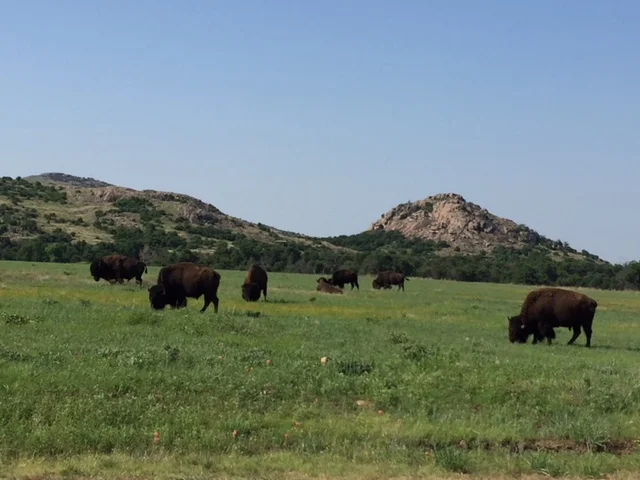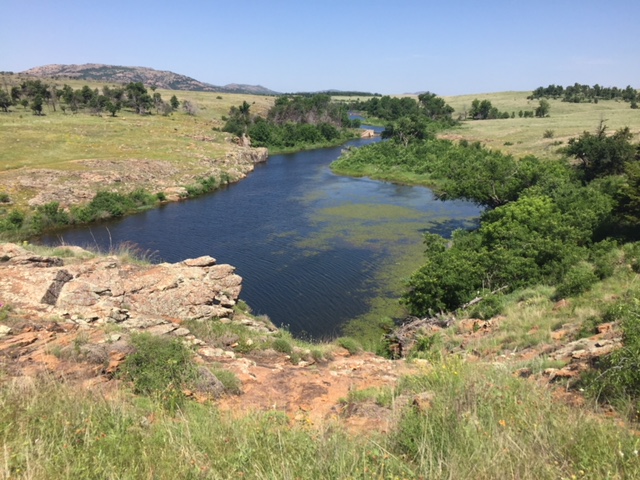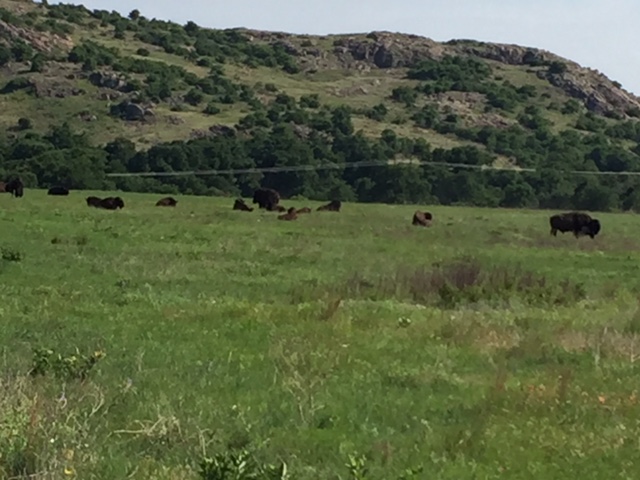Wichita Mountains National Wildlife Refuge
Lawton, Oklahoma
Sunday/Monday, May 27-28, 2018
Clear, 97°
“The real voyage of discovery consists not in seeing new landscapes, but in having new eyes.” — Marcel Proust
Another surprise Traveling Life’s Highways, on a blue line highway off the beaten path in southwest Oklahoma, is the Wichita Mountains Wildlife Refuge.
Refuge Marker
It is a one-of-a-kind destination located near Cache and Lawton. The refuge spans over 59,000 majestic acres and is home to free range buffalo, Texas longhorn cattle, prairie dogs, elk, wild turkeys, deer and other wildlife.
Free Range buffalo grazing
There are hiking trails all over so hikers and photographers are astounded by the amount of incredible scenery offered within the refuge.
On the drive to the top of Mount Scott, which stands 2,464 feet above sea level, each turn around the mountain gave a different view of the surrounding area. There are several hundred wind generators to the east, lakes to the south, and toward the west you can see the buffalo and Texas Longhorn cattle grazing in the meadows and fields below. There is a parking lot at the top of the mountain, so you can get out, walk around and enjoy the view.
Additional things to see within the Wichita Mountains Wildlife Refuge include the Holy City of the Wichita’s, Quanah Parker Lake and the Parallel Forest.
The Parallel Forest, which consists of large cedars planted exactly six feet apart from one another, stretches as far as the eye can see. Located just over one mile north of the intersection of Cache/Meers Road and Meers Road, the entrance to the Parallel Forest has a small parking lot near the edge of the forest. The trees were originally planted in the early 1900s, but before they were large enough to harvest the area became a refuge.
Arriving in the Refuge there were several events taking place for the Memorial Day weekend. One was the “America’s Run for the Fallen” who were making their way across the refuge among the bison and longhorns grazing nearby.
The America’s Run for the Fallen team will blaze a tribute trail across our nation, covering 5 months spanning over 6000 miles from San Diego to Arlington National Cemetery, recognizing nearly 20,000 fallen service members since the USS Cole. They left April 7th from California and will arrive in Washington on August 5, 2018
Runner
In one of the most comprehensive tributes ever organized this run will honor every service member who died while serving or as a result of serving since October 12, 2000. Calling each hero’s name out loud mile after mile, every stop will represent a unique chronological date of death.
RV’s supporting the runners
The men and women being honored include every service member who died during the War on Terror while on active duty or as a result of active duty, including all branches of service and all causes of death.
The other was the Tour de Meers, an annual bicycle ride of varying length through the Refuge. Bicyclists can choose routes of varying lengths depending on if they want to ride 10, 22, 36, 57 or 62 miles. The longer routes go through the wildlife preserve, where riders can see bison, longhorns, elk, deer, birds and several other species up close.
Tour de Meers, one of the region's oldest and most successful bike rides, is a must-ride for cyclists looking to pedal through a national wildlife refuge, a wind farm and the historic town of Medicine Park, which holds a music festival the same weekend.
Medicine Park was full of people walking through the vendor kiosk areas as well as people hitting the “swimming hole” where Medicine Creek comes down over a waterfall and flows into the swimming hole. There was music most of the day as people milled around town and just before dark the live band music cranked up with many people sitting in their folding chairs to listen as the sun went down and a full moon rose over the mountains.
Lake
It was a beautiful backdrop for a warm May night. This little known area drew in quite a few locals and people drove out from Ft. Sill Army Post in Lawton, Oklahoma to enjoy themselves.
Seeing all of these wonderful animals was a nice surprise as I did not know the buffalo and Texas Longhorns were there. I expected to see deer, elk, and maybe a turkey or two but to see these magnificent animals up close was nothing short of amazing.
Deer moon
There are many herds that number from five or six to over thirty or more scattered over the Reserve.
Buffalo herd
They seem to have daily migration patterns as they moved along about a two mile area crossing the roadway.
Buffalo moon
The Texas longhorn cattle seemed to have similar patterns as they wandered; grazed and crossed to different areas as they moved.
Longhorns by lake
The Longhorns were introduced in 1927 and today, the herd is maintained at about 600 head.
Longhorns crossing road
It felt great to see the buffalo making a comeback from near extinction. Between 1830-1880, the American bison or buffalo was reduced in numbers from 60 million to a mere handful. By 1900 there were but two small wild herds in all of North America, numbering only 550 animals. President Theodore Roosevelt who was concerned for the buffalo, Congress created the Wichita National Forrest and Game Preserve in Oklahoma.
Found the Original marker
The first buffalo came from the New York City Zoo in 1907. There were fifteen loaded on a train, and today are maintained at approximately 600 head. Surplus buffalo in excess of the refuge needs are sold live at public auction. Since 1907, more than 6,000 animals have been removed from the range by sale or donation in order to preserve the high quality of the Wichita grasslands. (Some information from the Wichita Mountains National Wildlife Refuge brochure)











